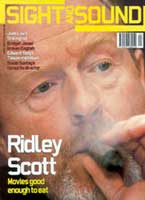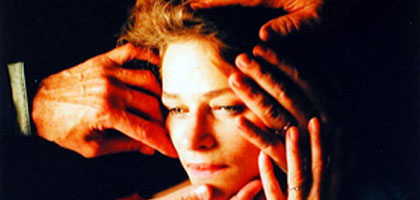
Under the Sand
France/Japan 2000

Reviewed by Ginette Vincendeau
Synopsis
Our synopses give away the plot in full, including surprise twists.
France, the present. Marie and Jean, a middle-aged, middle-class couple, drive from Paris to their country house in the south-west. The next day Jean disappears on the beach and, despite a police search, is not found. Back in Paris, Marie resumes her life as a university lecturer but refuses to accept Jean's death. She still sees and talks to him in her flat, even when the police ring to say they have identified his body. Through her best friend Amanda she meets Vincent, an attractive middle-aged man. After a brief affair she breaks up with him when he tells her to face reality. She discovers that, unknown to her, Jean was clinically depressed. Marie visits his mother who tells her she knew of Jean's condition, and explains that he was depressed because he was bored with her. She visits the morgue and insists on seeing Jean's body. Despite the weight of medical and circumstantial evidence, Marie continues to deny his death. She goes back to the beach, where she imagines she sees her husband in the distance.
Review
Like the beauty of its star Charlotte Rampling, Under the Sand is stylish and slightly haunted. Its director François Ozon suffuses the everyday life of the Parisian middle classes (those classic clothes, those elegant apartments) with a sense of dread. The film opens in a manner reminiscent of George Sluizer's The Vanishing and Dominik Moll's recent Harry, He's Here to Help, with an 'ordinary' couple driving to their holidays and stopping at a motorway café. But, as in these two films, we know immediately that something is wrong: Jean yawns all the time and refuses his wife Marie's discreet advances to make love; their country house is too neat, the beach too empty. Back in Paris, at her friend Amanda's dinner party, where she meets her future lover Vincent, Marie discusses Jean in the present tense. We are unsettled for a while: is this a flashback; has Jean, earlier reported missing at sea, returned? Indeed, when Marie returns home, Jean is back, inhabiting their old apartment as a ghostly presence. Slowly it dawns on us that Marie is deranged.
Although there is an element of mystery (Is Jean actually dead? Did he commit suicide or did he drown accidentally?), Under the Sand is not a thriller. Instead the film unfolds as the drama of a woman's grief, an apparently normal woman who goes to work and to the gym, who meets her best friend for lunch, takes the Metro and shops. Ozon's minimalist mise en scène of the quotidian - a departure from his farcical fantasy Sitcom - places him in the classic tradition of Claude Sautet or Bertrand Tavernier. Charlotte Rampling's intense but understated performance makes Marie utterly credible in her grief, even, initially at least, when she is denying that her husband is dead. Rampling's magnetic looks grace the film in a series of still compositions, both in the luminous scenes at the seaside and the darker ones in Paris. But the film gives Marie centre stage only to celebrate her emptiness.
Marie increasingly appears like the beach in the film: beautiful but vacant. In contrast to the plumper but happier Amanda, who's a great cook, Marie must have, as Vincent says, "other talents". But what are they? We soon find out they have little to do with her work, as her lecturing consists of reading bits from a book (one wishes it were that easy). Revealingly she tells Vincent that she has long abandoned plans to write. The film also makes two pointed references to her childlessness. Marie's life is thus presented as devoid of creation: her agency, such as it is, is her fidelity to a (literally and metaphorically) ghostly husband, about whom she knows so little that she failed to notice his clinical depression when he was alive; and her talents are erotic, as spectators might have inferred from Rampling's star persona. But Marie's eroticism is no joyful sensuality. She works hard at maintaining her beauty (the insistence on the gym begins to make sense), and her eroticism is repeatedly frustrated by her husband, whether alive or dead: she interrupts love making with Vincent with an odd laugh at the thought of Jean's body.
Concurrently, Marie is emphatically linked with death, through her association with water, the medium of her husband's disappearance: she teaches Virginia Woolf's The Waves and is seen through an aquarium at a Chinese restaurant. Marie's association with eroticism and death is also strongly based on Rampling's 'perverse' star image, derived from such films as The Night Porter (Nazi erotic games) and Max mon amour (love with a chimpanzee). Here, Marie/Rampling is the attractive but ultimately deadly femme fatale. In a brilliantly vicious sketch of the in-law from hell, Jean's mother tells Marie, who "could not even create a family", that Jean was suffering from depression because she bored him. Death by boredom, then - a new twist on the femme fatale's destructive ways. This may stretch the spectator's credibility - Bruno Cremer's Jean, even alive, is a heavy, silent presence against Marie's brightness and beauty, and you can't help thinking he may be the "boring" one. But we will never know, as Jean's life is otherwise off screen. Apart from playing out the cliché of wife and mother fighting for 'their' man, the point of the mother-in-law scene is to drive home further Marie's deadliness; it's when the mother suggests Jean has escaped to get away from her that she finally decides to see his body: for her, therefore, he is better dead than free.
Under the Sand is ostensibly the portrait of a woman who fantasises about her dead husband, but it actually presents us with a male fantasy of a morbid and unhinged femininity. As Violette Nozière and Betty Blue show, French cinema loves beautiful, tragic women who go crazy. That these women are portrayed by such expert directors as Claude Chabrol, Jean-Jacques Beineix and Ozon, and that they are embodied by such talented actresses as Isabelle Huppert, Béatrice Dalle and Charlotte Rampling, makes the fantasy more attractive, but also more bitter.
Credits
- Director
- François Ozon
- Producers
- Olivier Delbosc
- Marc Missonnier
- Screenplay
- François Ozon
- In collaboration with Emmanuèle Bernheim
- Marina de Van
- Marcia Romano
- Directors of Photography
- Winter:
- Jeanne Lapoirie
- Summer:
- Antoine Héberlé
- Editor
- Laurence Bawedin
- Set Decorator
- Sandrine Canaux
- Music/Music Conductor/Orchestrations
- Philippe Rombi
